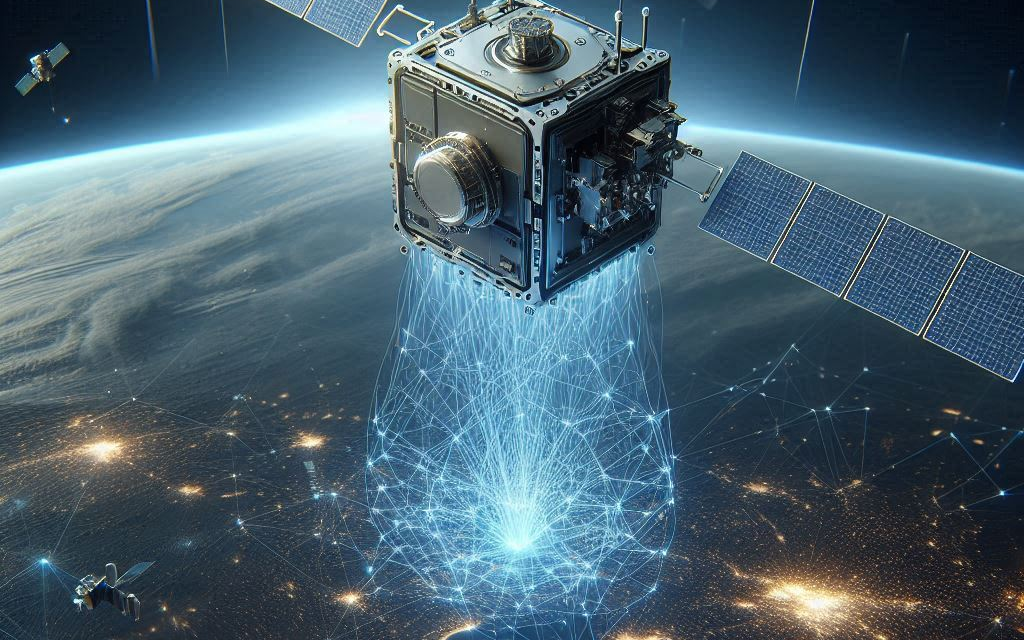The Challenge of AI Processing in Space
A. Azadi, CAVU Aerospace UK, September 2024 – The rapid advancement of artificial intelligence is transforming various industries on Earth, and its influence is now expanding into space exploration and satellite technology. The increasing deployment of CubeSats and the rising demand for low Earth orbit small satellite constellations for Earth observation, environmental monitoring, and communication have underscored the need for onboard data and image processing. As AI software and its capabilities advance, there is a growing trend to conduct processing directly on satellites, rather than transmitting raw data back to Earth. This article explores the current state of AI edge computing for space applications, the challenges posed by the harsh radiation environment in space, and whether current AI processors, particularly the NVIDIA Jetson series, are ready for these challenges.

The Need for Onboard Data Processing
Communication Bandwidth Constraints
One of the primary drivers for onboard data processing is the limitation of communication bandwidth between satellites and ground stations. Satellites, especially those in LEO, have limited windows of time during which they can communicate with ground stations. This short passing time, combined with limited bandwidth, creates a bottleneck in data transmission. By processing data onboard, satellites can significantly reduce the amount of data that needs to be transmitted to Earth. For example, instead of sending high-resolution images or raw synthetic aperture radar (SAR) data, a satellite could process the data onboard and only transmit essential information, such as detected anomalies or compressed results.
This approach conserves bandwidth and allows for faster decision-making and response times. In applications like disaster monitoring, a satellite equipped with onboard AI could detect and analyze natural disasters in near real-time, enabling quicker responses and more effective resource allocation.
High-Speed Laser Communication
High-speed laser communication offers an alternative to traditional RF communication, providing higher data rates that could alleviate some bandwidth constraints. However, laser communication is more efficient for satellite-to-satellite communication rather than satellite-to-Earth data transmission due to weather dependency and other factors like atmospheric interference. While promising, laser communication is not yet a complete solution for Earth-bound data transmission needs, especially in environments where consistent and reliable communication is critical.
Energy Efficiency
Another important consideration is the energy and environmental impact of data transmission. Transmitting large volumes of data from space to Earth requires significant energy, both on the satellite for transmission and on Earth for receiving and processing the data. Onboard processing can reduce the need for high-energy transmissions, potentially lowering the overall energy associated with satellite operations.
However, the trade-off lies in the power consumption of onboard AI processors. AI processing requires substantial computational resources, which in turn demand more power. In the context of space, where power is a limited resource, this raises the question of whether the energy savings from reduced data transmission outweigh the increased power consumption of onboard processing.
Storage Optimization
Storage is another critical factor in satellite operations. Satellites have limited onboard storage capacity, and raw data, particularly from high-resolution sensors, can quickly fill up this storage. By processing data onboard, satellites can compress or distill information, freeing up storage space for additional data collection. This is particularly advantageous in long-duration missions where the satellite might be collecting data continuously over extended periods.
The Challenge of Radiation in Space
Space Environment and Radiation Effects
The space environment is characterized by extreme conditions, including high levels of radiation from cosmic rays, solar particles, and trapped particles in Earth’s magnetic field. This radiation can cause various types of damage to electronic components, such as single-event upsets (SEUs), single-event latch-ups (SELs), and total ionizing dose (TID) effects. These effects can lead to data corruption, system crashes, or even permanent damage to onboard electronics.
AI processors, which are typically designed for terrestrial applications, are particularly vulnerable to these radiation effects. Their high complexity and dense transistor structures make them more susceptible to radiation-induced errors. Therefore, ensuring the reliability and robustness of AI processors in space is a significant challenge.
The Suitability of Current AI Processors for Space
NVIDIA Jetson Processors
The NVIDIA Jetson series has become a popular choice for AI processing in small satellites and CubeSats due to its powerful capabilities and cost-effectiveness. These processors are well-suited for tasks such as image recognition, data classification, and real-time decision-making. However, their suitability for space applications is a concern due to their lack of space qualification and radiation tolerance.
The cost of space-qualified AI processors, such as the AMD XQR Versal Adaptable SoCs, is prohibitively high for many small satellite manufacturers. The price difference between these processors and the NVIDIA Jetson series can be more than an order of magnitude, which significantly impacts the total cost of a CubeSat mission. As a result, many small satellite manufacturers opt for Jetson processors despite their unsuitability for the harsh space environment.
Comparing the AMD XQR Versal Adaptable SoC with Jetson series processors is not meaningful for most CubeSat and small satellite missions due to the vast difference in cost and intended use. However, commercial off-the-shelf (COTS) versions of Versal processors might be viable for less critical applications, where radiation exposure is lower, and the mission duration is shorter.
Radiation Testing and Preliminary Results
While the NVIDIA Jetson series has not been fully space-qualified, some efforts have been made to test its radiation tolerance. For instance, NASA Goddard Space Flight Center conducted proton testing on the Jetson TX1 and TX2, revealing numerous upsets and bit flips. The Jetson Xavier series, tested and discussed at the IEEE Radiation Effects Workshop in 2020, showed significant vulnerabilities, suggesting that this series requires careful consideration before being used in space.
Moreover, the Jetson Orin series, built on a 7nm process, has shown promising yet limited radiation tolerance. Recent tests indicate that the Orin series can withstand up to 19Krad(Si), which is marginally sufficient for a three-year LEO mission. The SEU performance and ability to operate through SEFIs suggest a surprisingly robust tolerance for a COTS system, but it still may not be ideal for all space applications.
On the other hand, AMD’s XQR Versal Adaptable SoC, also built on a 7nm architecture, claims suitability for missions lasting five to seven years. AMD’s radiation testing, conducted for LEO at 500 km for proton exposure and GEO for heavy-ion exposure, indicates the Versal SoC passed the gamma TID with over 120Krad(Si). This makes the Versal SoC a strong candidate for more critical and longer-duration missions, though at a much higher cost.
Jetson Silicon Technology and Radiation Susceptibility
The NVIDIA Jetson series employs a range of silicon technologies that vary in their radiation susceptibility. For instance, the Jetson TX1 and NANO, built on a 20nm process, might offer better resistance to radiation compared to newer models due to their larger transistor sizes. In contrast, the Jetson Xavier series uses a 12nm process, and the Orin series utilizes a 7nm process, both of which tend to be more susceptible to single-event effects due to their smaller transistor sizes.
The following tests are recommended to fully evaluate the suitability of these processors for space:
- Proton Testing: To evaluate SEE-induced parametric variations such as transients, SEFIs, and accessible device power-states.
- Heavy-Ion Testing: To determine the effects of different levels of Linear Energy Transfer (LET) on the device, particularly since smaller than 180nm CMOS architectures are more susceptible to destructive SEEs.
- Laser Testing: Involves exposing specific areas of the chip to laser pulses to simulate radiation effects, providing insights into chip vulnerability.
- Total Ionizing Dose (TID) Testing: Performed in an accelerated environment to characterize long-term radiation effects and determine dose-rate sensitivity.
Given the mixed results of current testing, it is clear that while some Jetson models may have limited use in space, their overall radiation tolerance remains a significant concern.
System Integration and Management
Given the vulnerabilities of AI processors like the NVIDIA Jetson series, it is essential to implement a comprehensive system management strategy. At CAVU Aerospace UK, we offer edge-computing solutions that integrate Jetson processors with additional layers of system management. Rather than using radiation-tolerant SoCs or FPGAs as redundant components, we recommend employing these components as system masters and supervisors. For example, our Tartan Series Edge Computer products utilize Microchip Flash-based FPGAs or SoCs to oversee the Jetson processors, ensuring data integrity, managing system health, and handling critical data operations.
This approach allows the Jetson processors to focus on their primary AI tasks, while the supervisory SoCs manage the overall system health and functionality, mitigating the impact of radiation-induced errors.
Conclusion
The challenge of AI processing in space is a complex and multifaceted issue that requires careful consideration of the limitations of current technology, the harsh radiation environment in space, and the specific needs of CubeSat and small satellite missions. While onboard AI processing offers significant advantages in terms of bandwidth conservation, energy efficiency, and real-time decision-making, it also presents challenges related to power consumption, storage, and radiation-induced errors.
The NVIDIA Jetson series, while popular for its cost-effectiveness and AI capabilities, is not yet fully suitable for space applications due to its vulnerability to radiation. As the space industry continues to grow and evolve, there is a critical need for the development of space-qualified AI processors and more extensive radiation testing. In the meantime, satellite manufacturers and mission planners must employ strategies to ensure the reliability and robustness of AI processing in space, balancing the trade-offs between onboard and Earth-based processing.
At CAVU Aerospace UK, we are committed to advancing edge-computing solutions for space applications, offering products like the Tartan Series Edge Computers that integrate AI processing with robust system management to meet the unique challenges of space. The future of AI in space holds great promise, but it will require continued innovation, collaboration, and research to overcome the challenges and unlock the full potential of AI-driven space exploration and observation.

